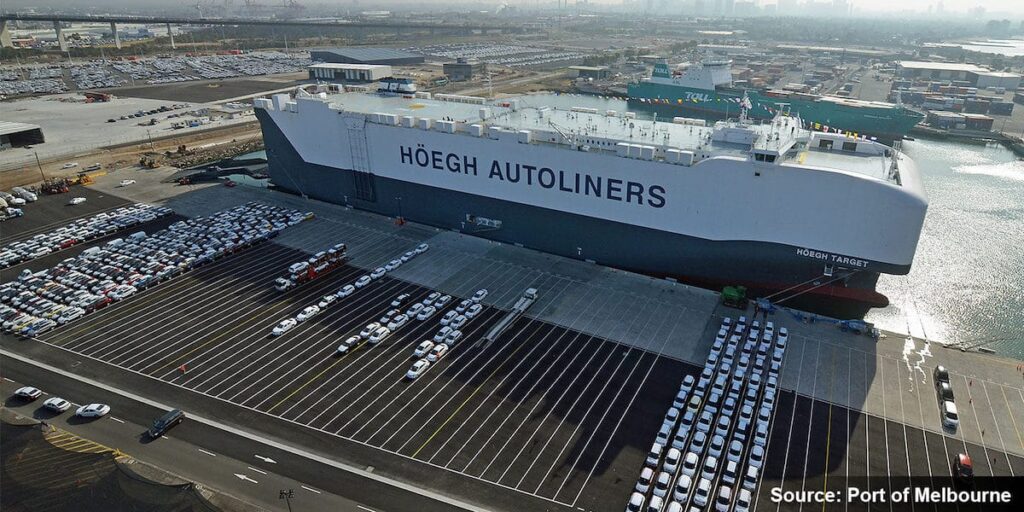
Shipping a vehicle by sea can be a convenient and cost-effective way to transport it over a long distance, whether you are moving, selling, or delivering the vehicle.
However, the process of shipping a vehicle by sea can be complex and involves a variety of factors to consider.
In this article, we will provide an ultimate guide to shipping a vehicle by sea, including tips, costs, and considerations to help you make informed decisions and ensure that the process goes smoothly.
Choose an Experienced Shipping Company
Choosing an experienced shipping company is an important step when shipping a vehicle by sea, as it can help to ensure that the process goes smoothly and that your vehicle arrives at its destination safely and in good condition.
Here are some obvious ways which you determine if you’re about to engage an experienced shipping company:
Research the company’s reputation
Look for a company that has a proven track record of successfully shipping vehicles and that has a good reputation in the industry. You can research the company’s reputation by reading customer reviews, asking for recommendations from friends or colleagues, or checking with trade associations or industry groups.
Check the company’s experience
Look for a company that has been in business for a long time and has a lot of experience shipping vehicles by sea. A company with a long history and a lot of experience is more likely to have the knowledge and resources to handle any issues that may arise during the shipping process.
Consider the company’s services and options
Choose a company that offers a range of services and options to meet your needs. This may include different shipping methods and vessels, insurance policies, tracking tools, storage options, and other services.
Get quotes from multiple companies:
Obtain quotes from multiple shipping companies to compare the cost and services offered. Be sure to get quotes from reputable and experienced companies, as the cheapest option may not always be the best.
Read the fine print
Be sure to carefully read and understand the terms and conditions of the shipping contract, including any exclusions or limitations on the company’s liability. This will help you to understand your rights and responsibilities and to protect yourself in case of any issues or disputes.
Overall, choosing an experienced shipping company is an important step when shipping a vehicle by sea and by following the tips above, you can ensure that you choose a reputable and experienced company that can handle any issues that may arise during the shipping process.
Understand the Shipping Process
It is also important to understand the shipping process and requirements, as these can vary depending on the shipping company, the type of vessel and shipping method, and the destination of your shipment.
Some common requirements include preparing your vehicle for transport, allowing extra time for the shipping process, insuring your vehicle, and gathering all necessary documents.
You should also be aware of any customs or import/export requirements that may apply to your shipment, as these can affect the cost and timeline of the shipping process.
Here are a few areas for you to research and understand about the shipping process:
Shipping companies: Look for a reputable and experienced shipping company that has a proven track record of successfully shipping vehicles by sea. Research the company’s reputation, experience, and services to ensure that it can meet your needs and handle any issues that may arise during the shipping process.
Shipping options: Research the different shipping methods and vessels available, and choose the one that best meets your needs. Common shipping methods include Roll on Roll off (RORO), container shipping, and Lift on Lift off (LOLO). Each method has its own advantages and disadvantages, and the best option for you will depend on your specific needs and preferences.
Shipping requirements: Research the requirements for shipping a vehicle by sea, including any documents, insurance, or other requirements that may be needed. Be sure to gather all necessary documents and meet any requirements to ensure that the shipping process goes smoothly.
Shipping timeline: Be aware of the timeline for the shipping process, including the transit time, any required preparation or preparation time, and any other considerations that may affect the timeline. Allowing extra time for the shipping process can help to ensure that you have enough time to handle any unexpected issues or delays.
Shipping costs: Research the costs of shipping a vehicle by sea, including the cost of the shipping company, the type of vessel and shipping method, the destination of your shipment, and any additional services or insurance you may require. Be sure to compare the costs of different shipping options to determine the best choice for you.
Overall, understanding the shipping process is an important step when shipping a vehicle by sea. By following these tips and researching the shipping company, options, requirements, timeline, and costs, you can ensure that the process goes smoothly and that your vehicle arrives at its destination safely and in good condition.
Prepare Your Vehicle for Shipping by Sea
Preparing a vehicle for shipping by sea is an important step to ensure that it arrives at its destination in good condition.
Clean and detail your vehicle: Clean and detail your vehicle to remove any dirt, grime, or debris that could cause damage during the shipping process. This may include washing the exterior, cleaning the interior, and waxing or polishing the exterior.
Remove any personal items or valuable items: Remove any personal items or valuable items from the vehicle to reduce the risk of loss or damage during the shipping process. This may include items such as clothing, electronics, or other personal items.
Ensure that your vehicle is in good working order: Check the condition of your vehicle and ensure that it is in good working order before shipping it by sea. This may include checking the tires, brakes, fluids, and other systems to ensure that they are in good condition.
Check with the shipping company about any specific requirements or restrictions: Check with the shipping company about any specific requirements or restrictions for shipping a vehicle by sea, such as size and weight limitations or prohibited items. This will help you to ensure that your vehicle meets any requirements and that the shipping process goes smoothly.
Take photographs of your vehicle: Take photographs of your vehicle before shipping it by sea to document its condition. This can be helpful in case of any disputes or claims related to the condition of your vehicle.
Overall, preparing a vehicle for shipping by sea is an important step to ensure that it arrives at its destination in good condition. By following these tips and checking with the shipping company about any specific requirements or restrictions, you can ensure that your vehicle is ready for the shipping process.

Allow Extra Time
Allowing extra time for the shipping process is also important, as shipping a vehicle by sea typically takes longer than driving or flying. The exact transit time will depend on the shipping company, the route and schedule of the vessel, and any delays or disruptions that may occur.
It is a good idea to allow extra time because:
Shipping a vehicle by sea typically takes longer than driving or flying: The exact transit time will depend on the shipping company, the route and schedule of the vessel, and any delays or disruptions that may occur. However, shipping a vehicle by sea typically takes longer than driving or flying, so it is a good idea to allow extra time for the shipping process.
Unexpected issues or delays may arise: During the shipping process, unexpected issues or delays may arise that can affect the timeline. Allowing extra time for the shipping process can help to ensure that you have enough time to handle any unexpected issues or delays that may occur.
It can help to reduce stress and allow for flexibility: Allowing extra time for the shipping process can help to reduce stress and allow for flexibility in case of any unexpected issues or delays. This can make the process of shipping a vehicle by sea more enjoyable and hassle-free.
Overall, allowing extra time when shipping a vehicle by sea is an important consideration to ensure that the process goes smoothly and that your vehicle arrives at its destination safely and in good condition. By allowing extra time, you can ensure that you have enough time to handle any unexpected issues or delays and that you have the flexibility to make any necessary adjustments to the timeline.
Insure your Vehicle
Insuring your vehicle is also an important consideration when shipping a vehicle by sea, as it can protect you in case of damages or losses that may occur during the shipping process. Specifically it will help:
To protect against loss or damage: Shipping a vehicle by sea involves a number of potential risks, such as loss, damage, or theft. Insuring your vehicle can help to protect against these risks and provide financial compensation if your vehicle is lost, damaged, or stolen during the shipping process.
To meet legal requirements: Some countries may have legal requirements for insuring your vehicle during the shipping process, particularly if you are importing or exporting it. Be sure to research the legal requirements in your destination country to ensure that you are in compliance.
To protect against liability: Shipping a vehicle by sea may also involve potential liability risks, such as damage to other vehicles or property. Insuring your vehicle can help to protect against these risks and provide financial compensation if you are found to be liable for any damages.
To provide peace of mind: Insuring your vehicle for shipping by sea can provide peace of mind and help to alleviate any concerns about the potential risks of the shipping process. By insuring your vehicle, you can have confidence that it is protected and that you have a financial safety net in case of any unexpected issues or losses.
Many shipping companies offer insurance as part of their services, but it is a good idea to check the terms and conditions of the policy to ensure that it covers any potential risks. You may also want to consider purchasing additional insurance or coverage from a third-party provider.
Gather Necessary Documents
Gathering all necessary documents is also essential when shipping a vehicle by sea. This may include documents such as the title or registration of the vehicle, proof of ownership, insurance documents, and any other documents required by the shipping company or by customs or import/export regulations.
It is a good idea to keep copies of these documents in a safe place in case you need to refer to them during the shipping process.
Vehicle title or ownership documents: You will need to provide proof of ownership of your vehicle, such as the title or registration documents. Be sure to check with the shipping company and your destination country about any specific requirements for ownership documents.
Bill of lading: The bill of lading is a document that outlines the terms of the shipping contract, including the parties involved, the description of the goods being shipped (including the vehicle), the route and schedule of the vessel, and any terms or conditions of the shipping contract. You will need to sign the bill of lading and provide it to the shipping company before your vehicle can be shipped.
Export/import documents: Depending on your destination country, you may need to obtain export or import documents to legally ship your vehicle by sea. Be sure to research the requirements for exporting or importing a vehicle in your destination country and gather any necessary documents.
Insurance documents: If you are insuring your vehicle for the shipping process, be sure to gather any necessary insurance documents, such as the insurance policy or certificate of insurance.
Other documents: Depending on your specific circumstances, you may need to gather other documents, such as a power of attorney, a letter of authorisation, or a notarised bill of sale. Be sure to check with the shipping company and your destination country about any specific requirements or documents that may be needed.
Overall, gathering the necessary documents before shipping a vehicle by sea is an important step to ensure that the process goes smoothly and that your vehicle arrives at its destination safely and in good condition. By researching and gathering the necessary documents in advance, you can ensure that you have everything you need to complete the shipping process.
Examine Costs Carefully
Another important consideration when shipping a vehicle by sea is the cost. The cost of shipping a vehicle by sea will depend on a variety of factors, including the shipping company, the type of vessel and shipping method, the destination of your shipment, and any additional services or insurance you may require.
Hidden fees or charges are fees or charges that are not clearly disclosed or are not included in the initial cost of shipping a vehicle by sea. Some common hidden fees or charges that you may encounter when shipping a vehicle by sea include:
Documentation fees
Some shipping companies may charge fees for preparing or processing documents, such as the bill of lading or export/import documents. These fees may not be clearly disclosed in the initial cost of shipping, so be sure to ask about any documentation fees and factor them into your budget.
Terminal handling fees
Some shipping companies may charge fees for handling your vehicle at the port or terminal, such as loading or unloading fees. These fees may not be clearly disclosed in the initial cost of shipping, so be sure to ask about any terminal handling fees and factor them into your budget.
Storage fees
Some shipping companies may charge fees for storing your vehicle at the port or terminal, either before or after the shipping process. These fees may not be clearly disclosed in the initial cost of shipping, so be sure to ask about any storage fees and factor them into your budget.
Customs clearance fees
If you are shipping your vehicle to a foreign country, you may be required to pay customs clearance fees to import or export your vehicle. These fees may not be clearly disclosed in the initial cost of shipping, so be sure to ask about any customs clearance fees and factor them into your budget.
Other fees
There may be other fees or charges associated with shipping a vehicle by sea that are not clearly disclosed in the initial cost. Be sure to ask about any additional fees or charges and factor them into your budget to ensure that you are aware of all the costs involved in the shipping process.
Overall, it is important to be aware of all costs; including hidden fees and charges when shipping a vehicle, as they can significantly impact the overall cost of the shipping process. By asking about and understanding any fees or charges that may be involved, you can ensure that you are aware of all the costs involved and that you are making an informed decision about the cost of shipping your vehicle.

Shipping Methods
There are several different shipping methods and vessels available for shipping a vehicle by sea, each with its own advantages and disadvantages.
Some common shipping methods include Roll on Roll off (RORO), container shipping, and Lift on Lift Off (LOLO).
RORO shipping involves driving your vehicle onto the vessel and securing it for transport, while container shipping involves placing your vehicle in a container and loading it onto the vessel.
LOLO shipping is usually used for extremely large machinery and boats and involves using a crane to lift your vehicle onto (and off) the vessel.
Each shipping method has its own advantages and disadvantages, and the best option for you will depend on your specific needs and preferences.
- RORO shipping is typically the most cost-effective option, but it may not offer as much protection for your vehicle as container shipping.
- Container shipping may be more expensive, but it can offer more protection and security for your vehicle, as well as the option to ship other items along with your vehicle.
- LOLO shipping may be the most expensive option, but it can be useful for shipping larger or irregularly shaped vehicles that cannot be transported using RORO or container methods.
When comparing the cost of shipping a vehicle by sea with other options, such as driving or flying, it is important to consider all of the costs and factors involved. Shipping a vehicle by sea may be more cost-effective than either driving or by road, particularly for long distances or international moves, but it is important to compare the total cost of each option to determine the best choice for you.
In conclusion, shipping a vehicle by sea can be a convenient and cost-effective way to transport it over a long distance, particularly for long distances or international moves. However, the process of shipping a vehicle by sea can be complex and involves a variety of factors to consider, including choosing a reputable and experienced shipping company, understanding the shipping process and requirements, preparing your vehicle for transport, allowing extra time for the shipping process, insuring your vehicle, and gathering all necessary documents.
We hope this ultimate guide to shipping a vehicle by sea helps you to make informed decisions and ensures that the process goes smoothly and that your vehicle arrives at its destination safely and in good condition.
Whether you are moving, selling or delivering your vehicle, shipping it by sea can offer a range of benefits, including cost-effectiveness, convenience, safety, security, time-saving, reduced wear and tear, no need for special driving skills, flexibility, ease of transport, and environmental benefits. By considering these benefits, you can decide whether shipping a vehicle by sea is the right option for you.





